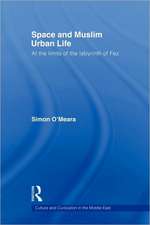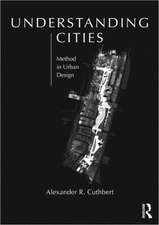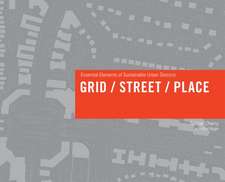Fundamental Trends in City Development: Urban and Landscape Perspectives, cartea 1
Autor Giovanni Macioccoen Limba Engleză Hardback – 15 ian 2008
| Toate formatele și edițiile | Preț | Express |
|---|---|---|
| Paperback (1) | 941.38 lei 6-8 săpt. | |
| Springer Berlin, Heidelberg – 30 noi 2010 | 941.38 lei 6-8 săpt. | |
| Hardback (1) | 947.85 lei 6-8 săpt. | |
| Springer Berlin, Heidelberg – 15 ian 2008 | 947.85 lei 6-8 săpt. |
Din seria Urban and Landscape Perspectives
- 18%
 Preț: 953.20 lei
Preț: 953.20 lei - 15%
 Preț: 648.05 lei
Preț: 648.05 lei -
 Preț: 434.44 lei
Preț: 434.44 lei - 15%
 Preț: 638.43 lei
Preț: 638.43 lei - 20%
 Preț: 548.46 lei
Preț: 548.46 lei - 15%
 Preț: 643.84 lei
Preț: 643.84 lei - 15%
 Preț: 642.51 lei
Preț: 642.51 lei - 24%
 Preț: 797.69 lei
Preț: 797.69 lei - 18%
 Preț: 953.03 lei
Preț: 953.03 lei - 15%
 Preț: 648.24 lei
Preț: 648.24 lei - 15%
 Preț: 642.51 lei
Preț: 642.51 lei - 18%
 Preț: 961.86 lei
Preț: 961.86 lei - 15%
 Preț: 640.37 lei
Preț: 640.37 lei - 24%
 Preț: 675.19 lei
Preț: 675.19 lei - 18%
 Preț: 933.27 lei
Preț: 933.27 lei - 18%
 Preț: 944.99 lei
Preț: 944.99 lei - 15%
 Preț: 649.87 lei
Preț: 649.87 lei - 15%
 Preț: 638.24 lei
Preț: 638.24 lei - 18%
 Preț: 948.61 lei
Preț: 948.61 lei - 18%
 Preț: 948.47 lei
Preț: 948.47 lei - 24%
 Preț: 778.71 lei
Preț: 778.71 lei - 18%
 Preț: 951.77 lei
Preț: 951.77 lei
Preț: 947.85 lei
Preț vechi: 1155.91 lei
-18% Nou
Puncte Express: 1422
Preț estimativ în valută:
181.36€ • 189.38$ • 149.77£
181.36€ • 189.38$ • 149.77£
Carte tipărită la comandă
Livrare economică 15-29 aprilie
Preluare comenzi: 021 569.72.76
Specificații
ISBN-13: 9783540741787
ISBN-10: 354074178X
Pagini: 228
Ilustrații: VIII, 220 p.
Dimensiuni: 155 x 235 x 17 mm
Greutate: 0.51 kg
Ediția:2008
Editura: Springer Berlin, Heidelberg
Colecția Springer
Seria Urban and Landscape Perspectives
Locul publicării:Berlin, Heidelberg, Germany
ISBN-10: 354074178X
Pagini: 228
Ilustrații: VIII, 220 p.
Dimensiuni: 155 x 235 x 17 mm
Greutate: 0.51 kg
Ediția:2008
Editura: Springer Berlin, Heidelberg
Colecția Springer
Seria Urban and Landscape Perspectives
Locul publicării:Berlin, Heidelberg, Germany
Public țintă
ResearchCuprins
Three Categories of Utopia.- The Discomposed City.- The Generic City.- The Segregated City.- Reinventing the City.
Textul de pe ultima copertă
Urban and Landscape Perspectives
G. Maciocco
Fundamental Trends in City Development
What do phenomena like sprawl, "generic city" or urban segregation have in common with the concept of city? The question is not particularly easy. It is nevertheless the inquiry this book is based on, mainly because of the bewilderment we feel when faced with these phenomena that are spread throughout the urban world and constitute a tall order for our concepts of city. Expressions like "discomposed city", "generic city" and "segregated city" refer to entities that share the loss of the city as a space of communication and social interaction and as the space of the public sphere.
In order to explore what we call the city adrift, certain positions of scholars of the city are analysed, using the utopia as an analytical category and referring to three kinds – the conservative utopia, liquidatory utopia and resistant utopia – which can perhaps significantly distinguish the different positions on current spatial trends of the city and, more generally, the phenomena emerging in the urban world.
This book inquires into how the city can be re-established as the space of dialogue and communication, how the spatial conditions of the public sphere can be created and the city retrieved. And what the features might be of a city retrieved and restored to its citizens.
The author adopts the concept of externity as an innovative element for the project for the city, a constituent feature of all those situations traditionally considered non-functional, therefore external, to our contemporary post-cities, which are consigned to us adrift through decomposition, genericity and segregation. We thus need to try to get the city to conserve and show its past even when not visible, and to continue nurturing theimagination of its inhabitants by urban action consisting perhaps of subtly improving their approach to the "void", the "small", to the past, the territory, in general, to all those spatial concepts which are in a sense external to our cultural worlds today, but which represent the most fertile material for the project for the city.
Giovanni MACIOCCO obtained a degree in Engineering in 1970 at the University of Pisa and in Architecture at the University of Florence in 1974. He is Full Professor of Town and Regional Planning, Director of the Department of Architecture and Planning and Dean of the Faculty of Architecture of the University of Sassari. He is Director of the International Laboratory on "the Environmental Project" and the "International Summer School on the Environmental Project and Territorial Planning", and PhD Supervisor for Architecture and Planning of the same Faculty.
He is the editor of the book series "Metodi del territorio", published by Franco Angeli, Milan, Director of the book series "Urban and Landscape Perspectives", edited by Springer Verlag, Berlin, Heidelberg, New York and a member of the editorial board of international magazines such as Plurimondi, Pluriverso and Territorio. His main field of research is urban and territorial space planning. Several of his architectural and urban space projects have been published in specialist books, international journals or columns.
Among his recent works, the following deserve a mention: La pianificazione ambientale del paesaggio, (FrancoAngeli, 1991); Le dimensioni ambientali della pianificazione urbana, (FrancoAngeli, 1991); La città, la mente, il piano, (FrancoAngeli, 1994); La città in ombra, (FrancoAngeli, 1996); La città possibile (Dedalo, 1997) with S. Tagliagambe; Les lieux de l’eau et de la terre, (Lybra immagine, Milan, 1998); Plurimondi, An International Forum for Research and Debate on Human Settlements, Wastelands (Dedalo, 2000);Territorio e progetto. Prospettive di ricerca orientate in senso ambientale, with P. Pittaluga (FrancoAngeli, Milan, 2003); "Il progetto ambientale nelle aree di bordo", with P. Pittaluga (FrancoAngeli, 2006).
G. Maciocco
Fundamental Trends in City Development
What do phenomena like sprawl, "generic city" or urban segregation have in common with the concept of city? The question is not particularly easy. It is nevertheless the inquiry this book is based on, mainly because of the bewilderment we feel when faced with these phenomena that are spread throughout the urban world and constitute a tall order for our concepts of city. Expressions like "discomposed city", "generic city" and "segregated city" refer to entities that share the loss of the city as a space of communication and social interaction and as the space of the public sphere.
In order to explore what we call the city adrift, certain positions of scholars of the city are analysed, using the utopia as an analytical category and referring to three kinds – the conservative utopia, liquidatory utopia and resistant utopia – which can perhaps significantly distinguish the different positions on current spatial trends of the city and, more generally, the phenomena emerging in the urban world.
This book inquires into how the city can be re-established as the space of dialogue and communication, how the spatial conditions of the public sphere can be created and the city retrieved. And what the features might be of a city retrieved and restored to its citizens.
The author adopts the concept of externity as an innovative element for the project for the city, a constituent feature of all those situations traditionally considered non-functional, therefore external, to our contemporary post-cities, which are consigned to us adrift through decomposition, genericity and segregation. We thus need to try to get the city to conserve and show its past even when not visible, and to continue nurturing theimagination of its inhabitants by urban action consisting perhaps of subtly improving their approach to the "void", the "small", to the past, the territory, in general, to all those spatial concepts which are in a sense external to our cultural worlds today, but which represent the most fertile material for the project for the city.
Giovanni MACIOCCO obtained a degree in Engineering in 1970 at the University of Pisa and in Architecture at the University of Florence in 1974. He is Full Professor of Town and Regional Planning, Director of the Department of Architecture and Planning and Dean of the Faculty of Architecture of the University of Sassari. He is Director of the International Laboratory on "the Environmental Project" and the "International Summer School on the Environmental Project and Territorial Planning", and PhD Supervisor for Architecture and Planning of the same Faculty.
He is the editor of the book series "Metodi del territorio", published by Franco Angeli, Milan, Director of the book series "Urban and Landscape Perspectives", edited by Springer Verlag, Berlin, Heidelberg, New York and a member of the editorial board of international magazines such as Plurimondi, Pluriverso and Territorio. His main field of research is urban and territorial space planning. Several of his architectural and urban space projects have been published in specialist books, international journals or columns.
Among his recent works, the following deserve a mention: La pianificazione ambientale del paesaggio, (FrancoAngeli, 1991); Le dimensioni ambientali della pianificazione urbana, (FrancoAngeli, 1991); La città, la mente, il piano, (FrancoAngeli, 1994); La città in ombra, (FrancoAngeli, 1996); La città possibile (Dedalo, 1997) with S. Tagliagambe; Les lieux de l’eau et de la terre, (Lybra immagine, Milan, 1998); Plurimondi, An International Forum for Research and Debate on Human Settlements, Wastelands (Dedalo, 2000);Territorio e progetto. Prospettive di ricerca orientate in senso ambientale, with P. Pittaluga (FrancoAngeli, Milan, 2003); "Il progetto ambientale nelle aree di bordo", with P. Pittaluga (FrancoAngeli, 2006).
Caracteristici
Provides a theoretical contribution to the project for the city departing from an interpretation of real international situations Comparative analysis is made of the different cultural positions, which are not configured as simple recognition but as elements for the project The theme of the city is faced both from the spatial and the social point of view, beginning with minority elements which enable unusual categories to be singled out to deal with the city’s problems










